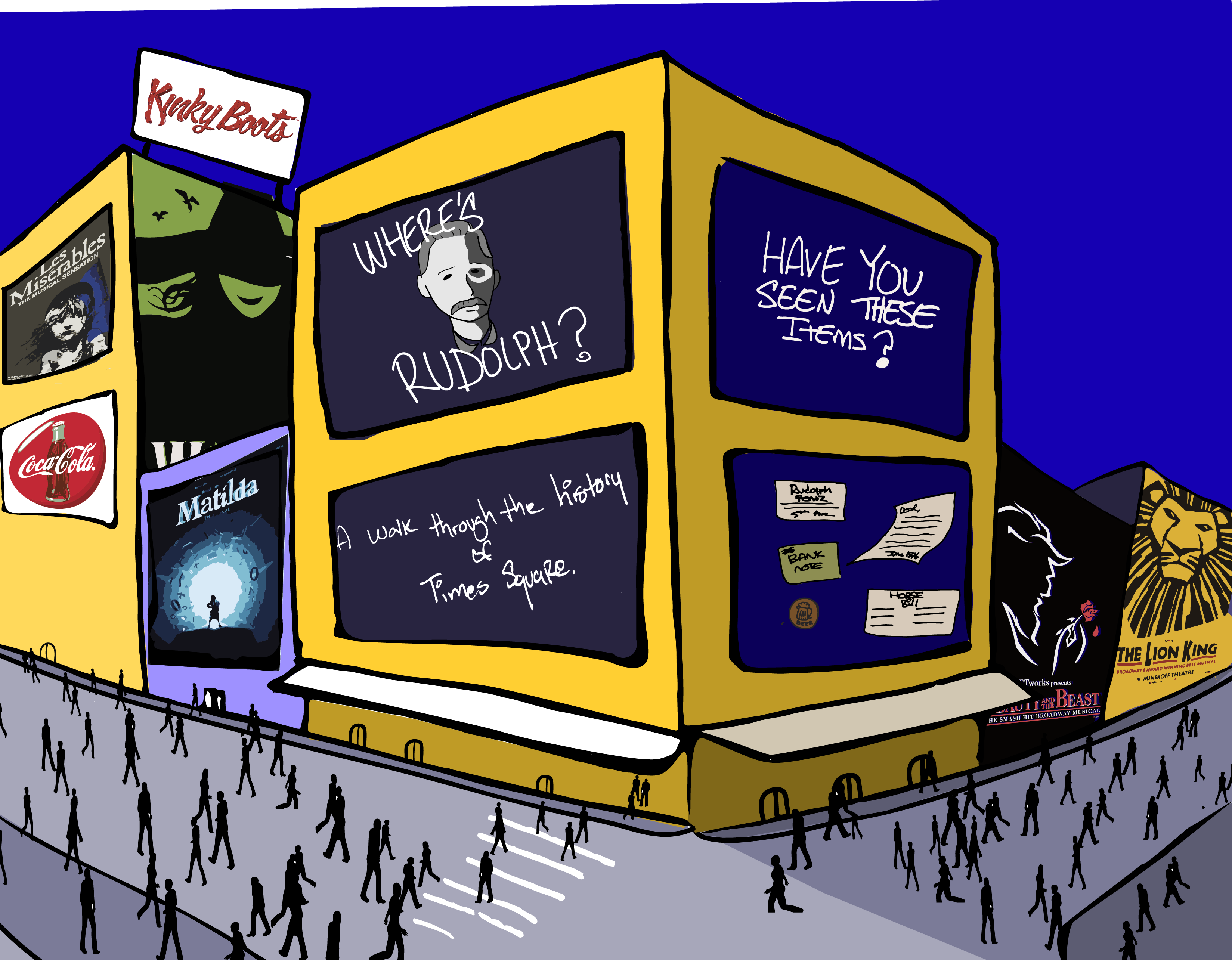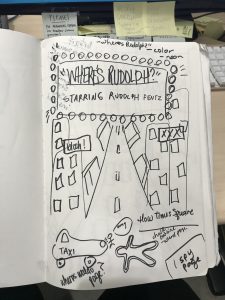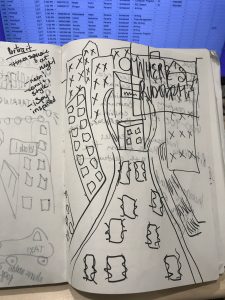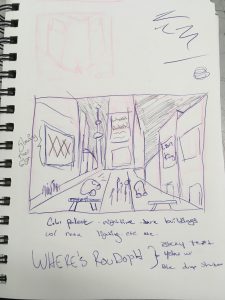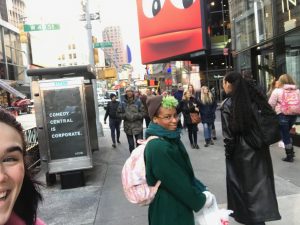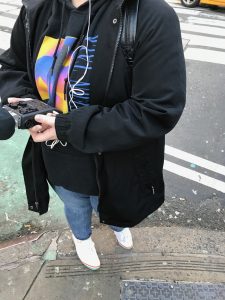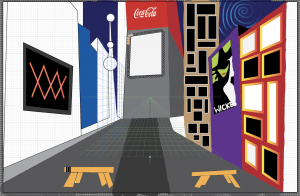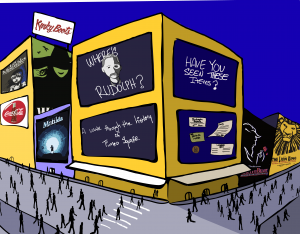First Brainstorming 11/7
- MIDTOWN:
- Times Square – desired neighborhood
- Myths:
- Times Square Time Traveller (Rudolph Fentz)
- Mole People
- Empire State Building (Penny experiment)
- Break it down by decades
- (e.g, 1950s-now)
- Myths:
- CHOSEN TOPIC: TIMES SQUARE TIME TRAVELLER – RUDOLPH FENTZ
First Poster Sketches 11/7
GROUP SCHEDULE:
GROUP PROJECT – BRIDGE # 4 – Sheet1-2e34sjo
Final Sketch 12/5:
This was the last sketch we can up with as a group and we decided on the title, “Where’s Rudolph: A walk through the history of Times Square”. We chose this because it both incorporated our myth and historical aspect perfectly.
Recording Session at Times Square:
Here at Times Square we started our recording session collecting street sounds, people, footsteps, traffic, etc. This provided a background noise throughout the entire soundwalk.
First Draft Poster Rendering:
In this first poster draft, I basically took a group sketch that we had all brainstormed together and made a rough illustrator mock up of what we wanted in the poster, color scheme, and general ideas.
Final Poster:
This is our final poster in which we advanced using illustrator in order to give it a more comic book style.
Final Soundwalk: “WHERE’S RUDOLPH: A walk through the history of Times Square”
file:///Users/julievantrease/Downloads/TIMES%20SQUARE-FINAL%20CUT_mixdown.wav
Final Historical Seminar Paper:
Savannah West, Mali Jack, Kristen DiGeloromo, Julie Vantrease
Sarah Montague
Integrative Seminar
3 December, 2017
A Brief History of Times Square
Times Square, located in Midtown, Manhattan has gone through many stages in its lifetime. In fact, it didn’t always hold the same name. Times Square was actually called Long Acre Square until 1904 when the New York Times bought the Times building. Adolph S. Ochs, owner and publisher of The New York Times from 1896 to 1935 stated that this was “the first successful effort in New York to give architectural beauty to a skyscraper…”
Before Times Square was a major tourist attraction, filled with lights and glam, it was dubbed as one of the sleaziest places in America. It was mainly known for its sex shops, prostitution, and drug trading. Some of the more drastic and larger changes of the area have happened over the last six decades. From the 1950’s to present, Times Square has seen many renditions of itself over the years. It has not just lived through history, but become a piece of history itself. The 1950s were not kind to Times Square. It became a haven of sex-related businesses, prostitution, hustling, and violent crime. This didn’t just happen by itself however; it was brought on by the Great Depression of the 1930s when people started moving out midtown to cheaper neighborhoods. This loss of residence caused many popular theaters like the Hammerstein’s Victoria Theatre to close. These once-famous spots were then transformed into saloons, brothels, burlesque halls, and grindhouse theaters. Times Square had taken on a new reputation as a very undesirable neighborhood.
By the 1960s, Times Square became known all over the city for crime and adult business. 42nd street theaters no longer showed iconic shows and movies, but rather now known for sex films and pornographic works. The New York Times had reported that 42nd street between seventh and eighth avenue was “the worst block in town”. This was no mere opinion, it was a fact. Over 2,300 annual crimes occurred on that single block (some being violent felonies such as murder or rape), that year alone. It also had acquired a reputation of vandalism and loitering. Midtown, Times Square had become a symbol of turmoil and decline for the city as a whole.
By the late 1970s, adult stores and theaters dominated Times Square. Prostitution flourished without interference from law enforcement and brothels, typically operated by organized crime, ran in the open without any legal repercussions. After a series of 1960s Supreme Court rulings protecting pornography as free speech and First Amendment protections, the intersection became a center for the burgeoning pornography industries. You could walk down any street in Times Square in the 70s and 80s and pass dozens of peep shows, pornographic video stores, theaters playing pornographic films, sex shops and prostitutes. During these decades the subway was considered the most dangerous mass transit system in the world During the time of the 1980s, crime rates soared. It is reported that on average, 250 felonies occurred weekly in the subway. The rise of crack cocaine in the 80s, and the ability to operate on the street made the area a haven for drugs.
By the mid-1980s there was a push by the then mayor, Edward I. Koch (which ended unsuccessfully). Even in the early 90s there was still tens of sex shops left over. This push to clean up Midtown was first initial step in polishing Times Square, into the commercial family destination it is today.Through the 1990’s to present day Times Square has seen massive change, in terms of its clean up. New Yorkers began to once again see the potential Times Square held, and began to take advantage of it. One of those people being former mayor Rudy Giuliani. He passed a law restricting sex shops from operating in certain areas. This was one of the first things leading to the new Times Square. Another major changes came when Walt Disney Corporation decided to renovate and buy the new Amsterdam theatre (one of the more historic theaters in Times Square).
Following that, many plays began to be shown on broadway. Beauty and the beast was one of the first shows leading to broadway becoming a booming business once again. The Lion King also contributed to this. This created a domino effect, many investors and advertisers saw the potential in marketing at Times Square. Thus leading more into modern day, where Times Square stands as beckon and bold representation of New York City.
Work Cited
Research done by Kristen, Julie, and Mali
Constructed by Savannah
Admin. “History of Times Square.” Admin. May 17, 2017. Accessed December 04, 2017. https://www.timessquarenyc.org/history-of-times-square.
Chakraborty, Deblina. “When Times Square was sleazy.” CNN. April 18, 2016. Accessed December 04, 2017. http://www.cnn.com/2016/04/18/us/80s-times-square-then-and-now/index.html.
Cunningham, Sean. “Does History Show Porn Started in Times Square?” RealClearLife. September 19, 2017. Accessed December 04, 2017. http://www.realclearlife.com/history/70s-times-square-came-went/.
Dailymail.com, Forrest Hanson For. “From capital of the porn industry to the capital of consumerism: The evolution of New York’s Times Square as James Franco’s new show The Deuce airs.” Daily Mail Online. August 25, 2017. Accessed December 04, 2017. http://www.dailymail.co.uk/news/article-4823302/Times-Square-porn-consumer-Deuce.html.
Nigro, Carmen. “The Changing Face of Times Square.” Nypl.org. January 12, 2015. Accessed December 04, 2017. https://www.nypl.org/blog/2015/01/12/changing-times-square.
Martin, Douglas. “Disney Seals Times Square Theater Deal.” The New York Times, www.nytimes.com/1994/02/03/nyregion/disney-seals-times-square-theater-deal.html.
P, A. “Did Giuliani Really Clean Up Times Square?” CBS News, 28 Dec. 2007, www.cbsnews.com/news/did-giuliani-really-clean-up-times-square/.
“Posts about Times Square 1950s on Ephemeral New York.” Ephemeral New York. 2012. Accessed December 04, 2017. https://ephemeralnewyork.wordpress.com/tag/times-square-1950s/.
Breakdown of the work:
(We all individually wrote our own sections of the narration and seminar final paper)
Savannah- Voice of Soundwalk Narration, edited the audio, edited first draft seminar paper.
Mali- Research for Soundwalk/Academic Paper, Poster.
Kristen- Research for Soundwalk/Academic Paper.
Julie- Poster, Research for Soundwalk/Academic Paper, edited final seminar paper.
